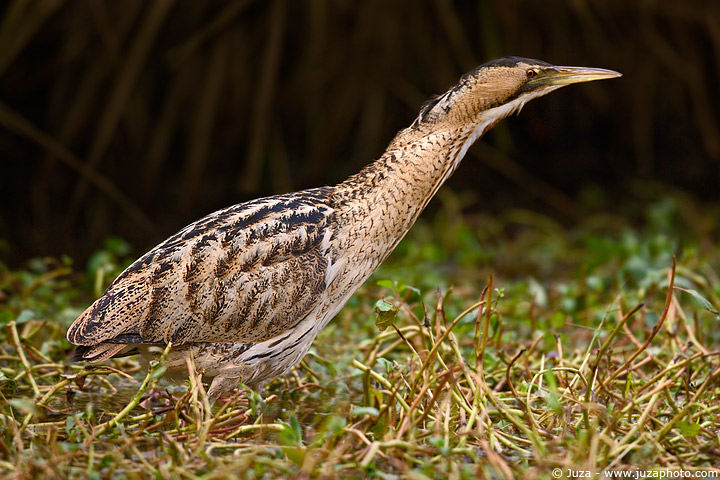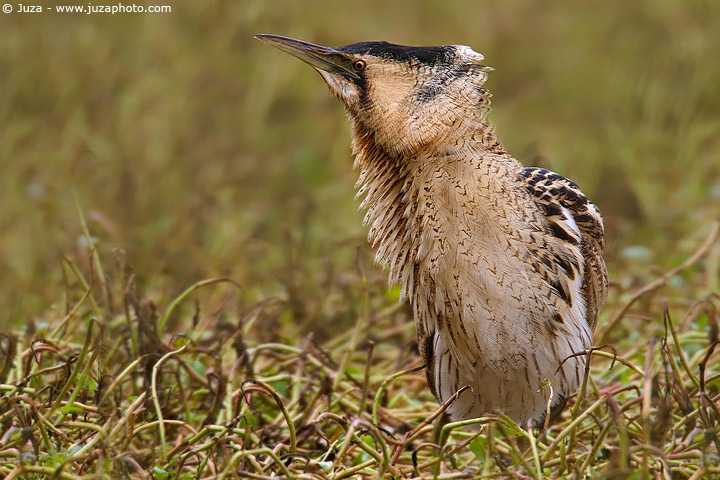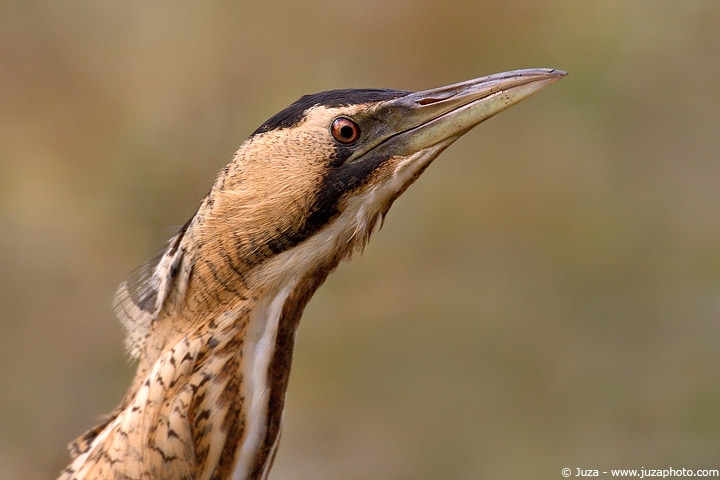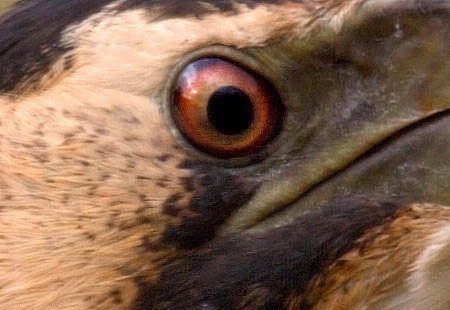Great Bittern and Canon 400 2.8
Great Bittern and Canon 400 2.8, testo e foto by
Juza. Pubblicato il 07 Giugno 2012; 0 risposte, 4550 visite.

Canon EOS 20D, Canon EF 400mm f/2.8 L IS USM, 1/500 f/2.8, iso 200, handheld. Torrile, Italy.
The Great Bittern is not a easy bird to photograph. Usually, it stays hidden in the reeds, and even when it comes out it is not easy too see, since it is well camouflaged between grasses and other water plants. I was quite surprised when two friends showed me good photos of this shy bird taken at Torrile - I visit this park since one year and I had never seen the Great Bittern. I've just loanded the Canon 400 2.8 L IS USM from CPS (Canon Professional Service), so I though that it was an excellent opportunity to try it in the field.
Yesterday, it was a cold, cloudy day, and I were alone in the hide. For more than two hours, there was no trace of the Great Bittern, but Maurizio (the manager of the park) told me that it was likely to see it around mid-day, so I waited. At 11:30, I saw something moving in the grass...the Great Bittern was arrived! I was impressed to see how well it was camounflaged, its feathers have the same color of the reeds and the grasses. Initially, I really missed the reach of my 600 f/4 (I had decided to rely exclusively on the 400 2.8 and I left the 600 at home) - the subject was pretty distant. To get the needed reach, I stacked the 1.4x TC and the 2.0x TC on the big lens, obtaining a focal length of 1120mm f/8. There was low light so I had to shoot wide open and at ISO 800 to get a decent shutter speed. I focussed with AI Servo and center AF area, even with my 20D - the camera see only one TC, so it considered the lens as a 800mm 5.6, so it focussed even with an actual aperture of f/8. On the other hand, the AF is so slow and it hunts so much and it was close to be useless.

Canon EOS 20D, Canon EF 400mm f/2.8 L IS USM, Canon 1.4x TC, Canon 2.0x TC, 1/200 f/8, iso 800, tripod. Torrile, Italy.
The Great Bittern was moving very slowly and it "puffed" the feathers in this curious pose. Here, I regret having used the stacked TCs - even though the image quality is still acceptable for a 20x30cm print (8x12"), there is not any gain in detail in respect to the 400 + 2.0x...in other words, if I had photographed this scene with the bare 2x instead of the stack, I'd have had the same amount of detail, or even better....with the 400 2.8 and an high resolution camera as the 20D, cropping and enlarging a photo taken with the 2x gives better results than stacking the 1.4x and 2x TC. (the same holds true for the 500 f4 and 600 f4 as well)

Canon EOS 20D, Canon EF 400mm f/2.8 L IS USM, Canon 2.0x TC, 1/500 f/5.6, iso 400, handheld. Torrile, Italy.
The bird continued to move very slowly towards the hide. Aften ten minutes, when it was at no more than 20 meters, it stopped and he stared at me. I was still with the 400 2.8 turned right toward him. Was it actually looking at me? Or something ealse had caught its attention? In either case, it was not scared at all - it continued to come close, and I was able to take frame-filling photos with the bare 400 2.8 and no TCs. This lens shines when it is used without TCs. In my opinion it is a great choice if you plan to use it as 400mm f/2.8 for the 90% of times - if you stop down by one or two stops, you have essentially throw away some thousands of dollars, since you could have got the 400 5.6 (extremely sharp, but much lighter, smaller and cheaper) or the 300 2.8 with 1.4x TC. The same holds true for teleconveters. If you need focal length, the 500 f/4 or the 600 f/4 are a much better choice - they gives a lot more reach and less need for TCs (thus better image quality: the 600+1.4x is much sharper than 400 + 2x). The 400 2.8 is almost as big and heavy as the 600 f/4, so there isn't even a weight advantage.

400 2.8 with 2.0x TC, wide open - detail of previous photo. The image quality is still pretty good even with the 2x TC and f/5.6. Don't misundertand my words - the 400 f/2.8 is an awesome lens, and I'm enjoying every moment that I spend with it - but it is more a "sport lens" or a lens for large animals, while the 500 f/4 and the 600 f/4 are more "general purpose" wildlife lenses. Anyway, yesterday it has a lucky morning: the Great Bittern is quite larger and, as I said, it come so close that I managed to photograph it with the bare 400 2.8, so I was really able to take advantage of this lens. I love the separation from background that I got from the f/2.8 - if the same photo had been taken with a 400 5.6, the background would have been way more distracting. And the detail, even wide open, is awesome!
Aften taking the usual photos of the entire bird, I decided to take some portrait, so I mounted the 2.0 TC. The image quality of the 400 2.8 with 2.0x TC is very good even wide open (that is f/5.6), but not as good as the 600 f/4 with 1.4x. Anyway, I didn't have any hesitation to use it at 5.6 - I prefer to trade a little of sharpness to get a nicely out of focus background; if I had stopped down to f/8 or f/11 for the maximum sharpness the background wouldn't have been so nice.
I choose to handhold the lens to have more freedom of movement and I choose the angle that gave me the best background...with a supertele it is enough to change a little the angle to get a completely different background. The image stabilizator assured a perfect sharpness.
Risposte e commenti
Che cosa ne pensi di questo articolo?
Vuoi dire la tua, fare domande all'autore o semplicemente fare i complimenti per un articolo che ti ha colpito particolarmente? Per partecipare iscriviti a JuzaPhoto, è semplice e gratuito!
Non solo: iscrivendoti potrai creare una tua pagina personale, pubblicare foto, ricevere commenti, partecipare alle discussioni e sfruttare tutte le funzionalità di JuzaPhoto. Con oltre 255000 iscritti, c'è spazio per tutti, dal principiante al professionista.





 JuzaPhoto contiene link affiliati Amazon ed Ebay e riceve una commissione in caso di acquisto attraverso link affiliati.
JuzaPhoto contiene link affiliati Amazon ed Ebay e riceve una commissione in caso di acquisto attraverso link affiliati.